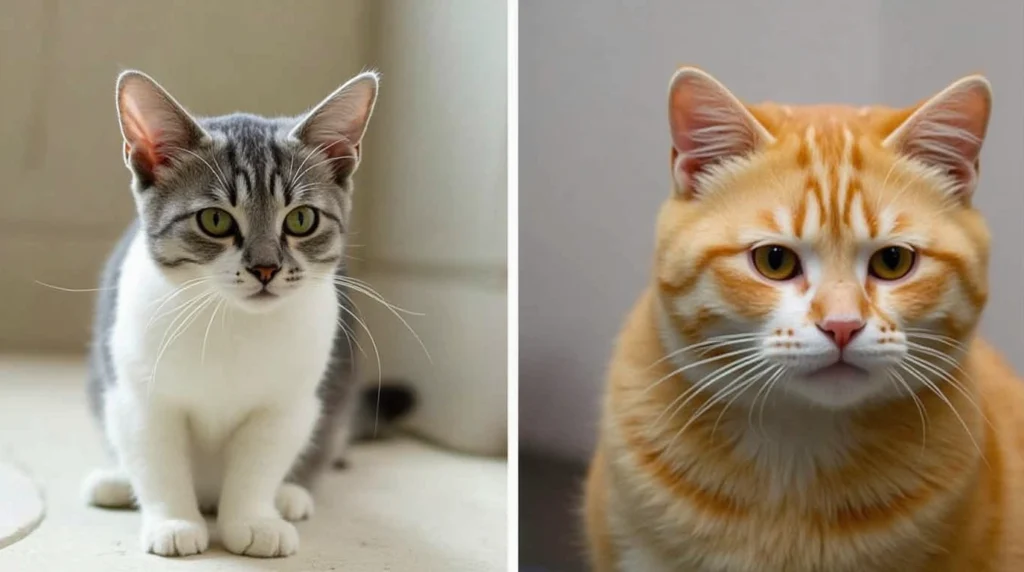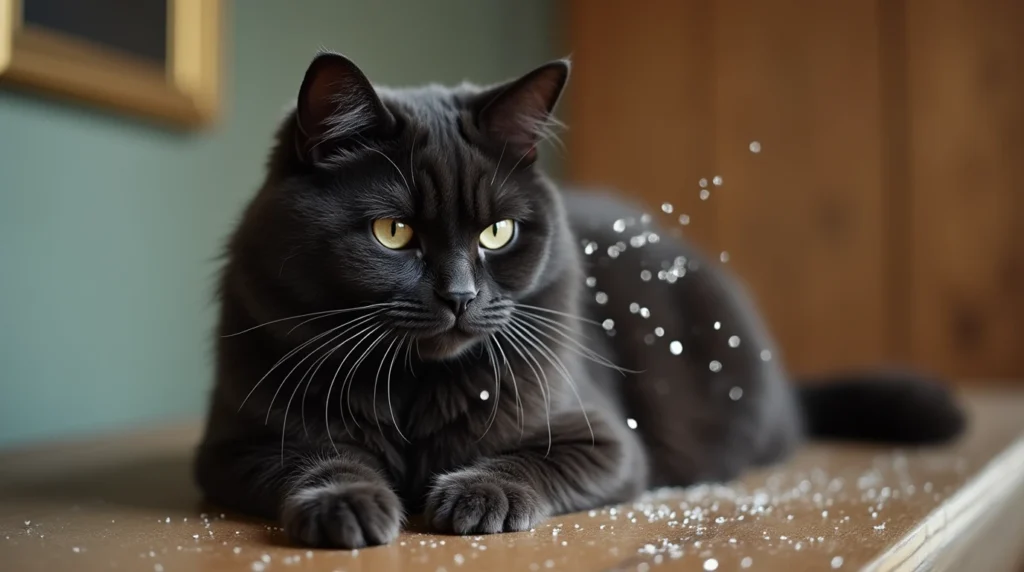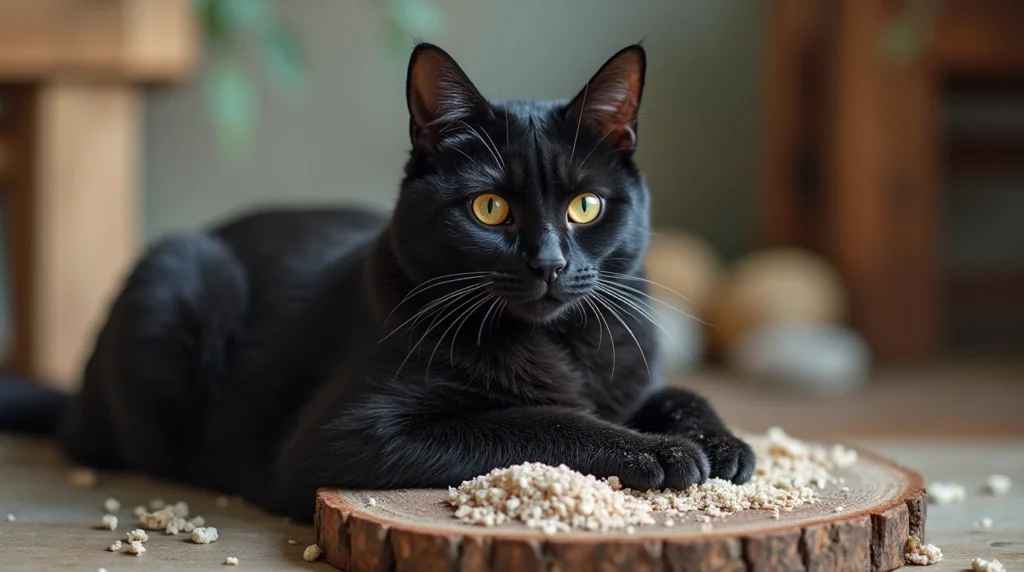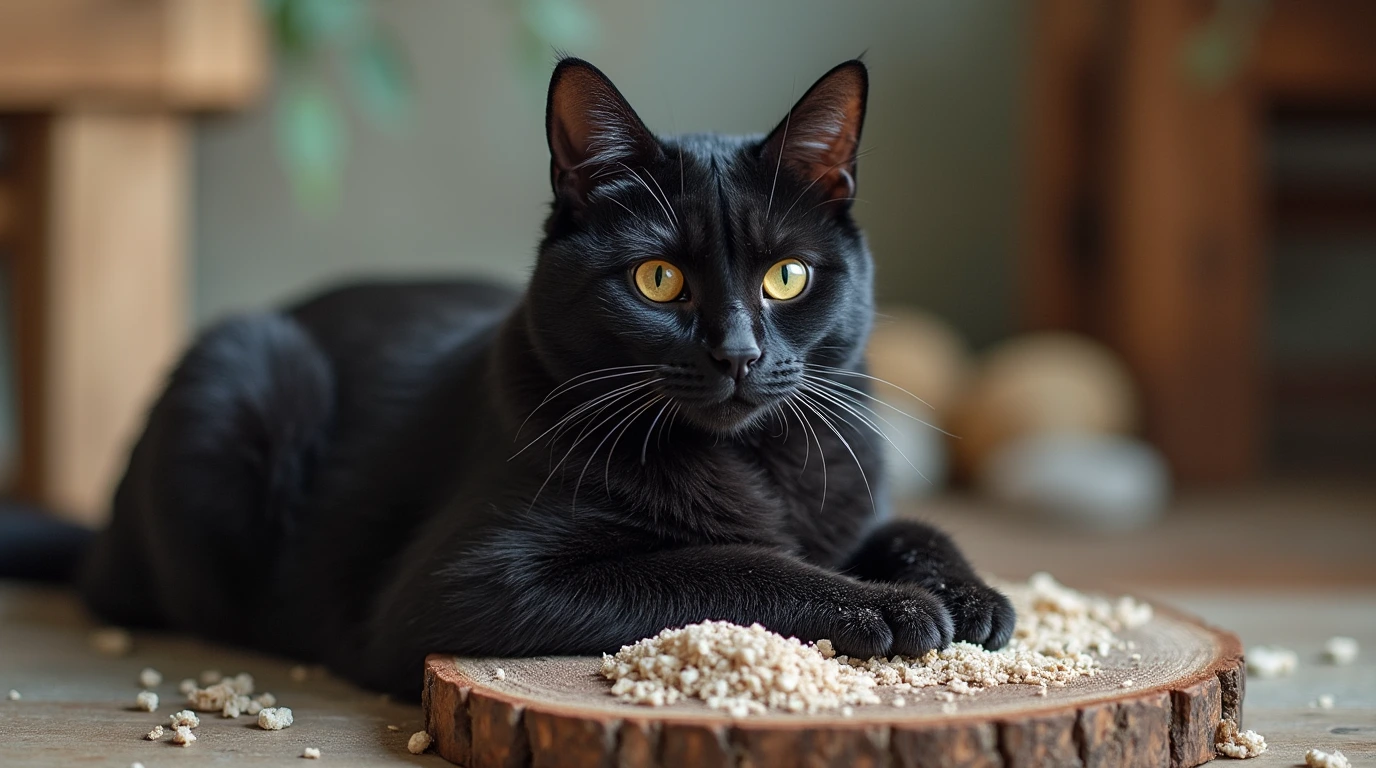If you’ve ever found yourself mesmerized by the variety of cat coats, you’re not alone. Cats, with their enchanting personalities and endless charm, also come in a stunning array of coat colors and patterns. But what if we told you that some of these patterns are so rare that they seem almost magical? From the mysterious salty licorice cat coat to the enchanting chinchilla silver, rare coat colors are a visual treat for cat lovers and are often a sign of unique genetic traits.
In this article, we’ll take a deep dive into 12 rare cat coat colors and patterns that are as striking as they are fascinating. Whether you’re an avid cat lover, a breeder, or simply curious, you’ll discover the beauty and charm behind these rare feline appearances. Let’s start by exploring the salty licorice cat coat, one of the most coveted and mysterious patterns around.
Table of Contents
The Fascinating World of Rare Cat Coat Colors and Patterns

1. Salty Licorice Cat Coat: A True Rarity
When you think of rare and unique cat coats, one name that might come to mind is the salty licorice cat coat. This striking pattern is among the most unusual and eye-catching, with its bold dark tones and shimmering tips. It’s the kind of coat that immediately grabs attention, thanks to its deep, dark base color—almost charcoal—that transitions to lighter, silvery tips. The end result is a coat that resembles salty licorice candy, an unusual yet beautiful appearance.
What is the Salty Licorice Coat?
The salty licorice cat coat is rare, caused by a specific genetic mutation. It appears most commonly in certain cat breeds, such as the Maine Coon or British Shorthair, but it can occur in other breeds as well. The gene responsible for this coat color is recessive, meaning both parents must carry the gene for their kittens to inherit this unique look.
Main Features of the Salty Licorice Coat
- Coloration: The salty licorice coat features a dark, nearly black base with lighter tips that shimmer like a silver halo around the fur. This gives the cat a smoky, metallic appearance.
- Genetic Rarity: The genetic mutation that produces this coat is rare, which is why not every cat can have this mesmerizing pattern.
- Caring for This Coat: Cats with this rare coat often need regular grooming to maintain their beautiful shine and prevent matting. Regular brushing ensures that the fur remains soft and healthy.
This unusual coat not only looks beautiful but also stands as a testament to the wonders of genetics and the diversity within the feline world.
2. Lavender Point Pattern
If you’re drawn to pastel colors, the lavender point pattern will surely capture your heart. This rare pattern is found in a select few breeds, most notably the Siamese and Ragdoll. Lavender points are soft, cool hues of lilac that appear on the cat’s ears, tail, and paws, creating a delicate, almost dreamlike appearance.
Origin of Lavender Points
The lavender point pattern is the result of a genetic mutation that lightens the traditional darker points seen in breeds like the Siamese. The light lilac tones are cool in nature, contributing to the overall soft, gentle look of the cat.
Main Features
- Soft and Pastel: The lavender coloration is soft, soothing, and typically ranges from a light lilac to a silvery lavender.
- Breeds: This pattern is most commonly seen in breeds like the Siamese, Ragdoll, and Balinese.
- Personality: Cats with this pattern often share the affectionate and playful personalities typical of the breeds they belong to.
Lavender point cats are rare, and their delicate look is one that captures the imagination of anyone who sees them.
3. Cinnamon and Fawn Coats
Cinnamon and fawn coat patterns are among the rarest in the feline world. These coats are characterized by soft, muted hues of brown, beige, and light red, giving them a warm and velvety appearance. These colors are far more subtle than typical brown or red tones, creating an elegant and understated beauty.
Genetics Behind Cinnamon and Fawn
The cinnamon and fawn coats are the result of a recessive gene that lightens the traditional brown tabby markings. These rare coats occur in various breeds, but are most commonly seen in breeds like the Abyssinian, Bengal, and Oriental Shorthair.
Main Features
- Soft and Muted: The cinnamon and fawn coats have a soft, muted appearance, blending hues of brown, cream, and red.
- Uncommon in Appearance: While not as flashy as other coat patterns, their elegance is undeniable. These coats make for a calm, sophisticated appearance.
Caring for cats with cinnamon and fawn coats generally involves regular grooming to keep the coat smooth and healthy.
4. Smoke Pattern
The smoke pattern is another rare and mesmerizing coat color that creates a stunning contrast between dark tips and light roots. This pattern is mostly found in long-haired breeds, like the Persian, and is known for its dramatic, ethereal appearance.

What Makes the Smoke Pattern Special?
The smoke pattern is the result of a genetic trait that causes the tips of the fur to be darker, while the roots remain light. When light hits the coat, it creates a smoky effect, giving the cat a glamorous and mysterious look.
Main Features
- Contrasting Colors: The stark contrast between the dark tips and light roots gives the cat a smoky, otherworldly appearance.
- High Maintenance Grooming: Because of the long fur typical of cats with the smoke pattern, regular grooming is a must to maintain the coat’s elegance and to prevent tangles.
- Breeds: While the smoke pattern can appear in several breeds, it is most commonly seen in Persian, British Shorthair, and Russian Blue cats.
5. Tortoiseshell with a Twist: Blue and Cream
If you’ve ever seen a tortoiseshell cat, you’ll know that their coats are a stunning mix of black, orange, and white. But the blue and cream tortoiseshell takes this a step further, with softer, muted versions of these colors.
Rare Tortoiseshell Variations
Tortoiseshell cats are almost always female, due to the genetics behind the color pattern. However, the blue and cream variation occurs when the orange and black colors are diluted, creating a softer, more pastel look.
Main Features
- Pastel Hues: Blue and cream tortoiseshells are characterized by their soft pastel hues of blue and cream, rather than the typical bright orange and black.
- Breeds: This coat can be found in breeds like the British Shorthair, Maine Coon, and Persian.
6. Chinchilla Silver Pattern -salty licorice cat coat
The chinchilla silver pattern is a showstopper. It features a coat that appears almost completely white but has a subtle silver sheen, especially at the tips of the fur.
Origin and Characteristics of the Chinchilla Coat
This coat is the result of a recessive gene that causes each hair to have a silver tip, creating a shimmering, ethereal effect.
Main Features
- Shiny and Elegant: The chinchilla coat is known for its gleaming appearance, which looks like it was dusted with silver.
- Breeds: This pattern is most often seen in Persian cats, though it can occasionally be found in other breeds.
7. Sepia Coat Pattern – salty licorice cat coat
Sepia is a rich, deep brown tone, with an almost reddish hue, that is incredibly rare in the feline world. Cats with this coat have a velvety appearance and are often found in Burmese cats.
What Sets the Sepia Pattern Apart?
Sepia coats are darker and richer than the standard brown tabby markings, giving cats a more luxurious and deep appearance.
Main Features
- Velvety Look: Sepia is a warm, deep brown with reddish undertones, giving the cat a sophisticated and velvety look.
- Breeds: Sepia coats are most commonly seen in Burmese and Tonkinese cats.
8. Mackerel Tabby with Distinctive Markings– salty licorice cat coat
The mackerel tabby is a classic pattern, but what makes it rare is the distinctive markings. Unlike other tabby patterns, mackerel tabbies feature thin, parallel stripes running along the body that resemble a fish skeleton.
What Makes the Mackerel Tabby Unique?
Mackerel tabby markings are the result of a gene that creates thin, evenly spaced stripes, rather than the more irregular “classic” tabby markings.
Main Features
- Parallel Stripes: Mackerel tabbies have parallel, thin stripes that run along the length of their body.
- Breeds: Mackerel tabby cats can be found in breeds like the Maine Coon, Abyssinian, and Bengal.
9. Bicolor with High Contrast – salty licorice cat coat
Bicolor cats, especially those with a high contrast between their white and dark markings, are rare and absolutely stunning. These cats typically have a solid white base with bold patches of dark colors like black or orange.
What Defines a High Contrast Bicolor?
Main Features
- Bold Color Blocks: High contrast bicolor cats typically have starkly divided patches of color, often with white legs, chest, and face.
- Breeds: This pattern can appear in a variety of breeds, including British Shorthair and Domestic Shorthair.
10. Mink Point Pattern– salty licorice cat coat
The mink point pattern is a middle ground between the traditional point coloration and a full-body color. It’s a warm, medium-dark tone that appears primarily on the cat’s points, with the rest of the body being lighter.
What Makes Mink Points Special?
Mink points provide a softer, warmer contrast than the stark contrast seen in traditional Siamese points, creating a more subtle look.
Main Features
- Warm Tones: Mink points are usually a warm brown or beige color, providing a soft and elegant appearance.
- Breeds: The pattern is most commonly seen in breeds like the Burmese, Tonkinese, and Ragdoll.

11. Calico with Rare Markings– salty licorice cat coat
The calico pattern is already quite popular, but the rarest calico cats have unique and unexpected markings. Some of these cats have asymmetrical patterns or unusual color distributions that make them stand out even more.
Rare Calico Variations
Some calicos have an unusually small amount of white or have their orange and black patches distributed in irregular, asymmetrical patterns.
Main Features
- Irregular Markings: The rarest calicos have unexpected and irregular patterns that can be both striking and beautiful.
- Breeds: Calico patterns can appear in a variety of breeds, including the American Shorthair and Maine Coon.
12. Snowshoe Coat Pattern-salty licorice cat coat
The snowshoe coat pattern is another fascinating rarity. It features a predominantly white coat with dark markings on the face, ears, tail, and paws, resembling the pattern of a snowshoe.
What Defines the Snowshoe Pattern?
The pattern is known for the distinct white “socks” on the cat’s legs and a “V” shaped marking on its face.
Main Features
- Distinct White Markings: Snowshoe cats have distinctive white “socks” and a “V” shaped marking on their face.
- Breeds: Snowshoe pattern is most common in the Snowshoe breed.
Pros and Cons of Rare Cat Coat Colors and Patterns
Pros:
- Unique Appearance: Rare coat colors and patterns give your cat a distinctive look that’s sure to turn heads.
- Breed Significance: Many of these patterns are associated with specific, often prestigious, breeds.
- Grooming Appeal: Some rare coat colors require more care, but they also tend to look stunning with the right maintenance.
Cons:
- Higher Maintenance: Rare coat colors often require more grooming to maintain their beauty.
- Health Risks: Some of these rare colors may be linked to specific genetic mutations, making them prone to certain health issues.
- Cost: Cats with rare coat colors or patterns can be more expensive due to their rarity and breeding demands.
Frequently Asked Questions
Q1: What is the salty licorice cat coat?
The salty licorice coat is a rare pattern characterized by a dark, nearly black base with lighter tips, giving it a shimmering, metallic appearance. It’s a beautiful and rare genetic trait.
Q2: Why are some cat coat colors so rare?
Cat coat colors become rare due to genetic mutations that occur only in specific breeds or bloodlines, often due to recessive genes.
Q3: How can I find a rare coat pattern cat?
Finding a rare coat pattern typically requires reaching out to breeders who specialize in that pattern, as well as checking rescue shelters or online adoption sites.
The Science Behind New Cat Colors: How Are They Discovered?
The feline world is constantly evolving, with new cat colors emerging due to genetic mutations, selective breeding, and spontaneous variations. Understanding how these unique coat colors, including the Salty Licorice Cat Coat, come to exist requires a deep dive into feline genetics.
Genetic Mutations and Their Role in New Cat Colors
- Cat coat colors are primarily determined by the interaction of pigment genes, melanin distribution, and modifier genes.
- A mutation in the agouti gene (ASIP) can lead to unique shading, creating effects like the salmiak cat pattern.
- The dilution gene impacts coat intensity, potentially contributing to the salty licorice cat coat, a variation that blends dark and light fur in an unusual way.
The Role of Cat Registries in Recognizing New Colors
- Organizations such as The International Cat Association (TICA) and Cat Fanciers’ Association (CFA) document and approve new cat colors.
- Breeders must provide genetic proof and consistent reproduction of a new color before it gains recognition.
- Recent trends in cat coat colors, including the new cat color salmiak, have sparked discussions about whether they are true genetic variations or simply rare expressions of existing genes.
The Salmiak Cat: A Mystery or a New Coat Variation?
The term Salmiak Cat is gaining traction among cat enthusiasts, drawing comparisons to the Salty Licorice Cat Coat. But is it a distinct coat pattern, or simply a variation of another rare color?
What is a Salmiak Cat?
- “Salmiak” refers to salty licorice, a dark confection known in Nordic regions, which mirrors the deep, smoky hues of certain feline coats.
- Some breeders and geneticists speculate that the salmiak cat coat results from a unique gene expression, possibly linked to a rare form of melanism or silver shading.
- It is still an unofficial term in cat genetics, but its increasing popularity suggests that it may soon be classified as a legitimate new color.
Why Cat Lovers Are Fascinated by Unique Coat Colors
Rare cat coats capture the imagination of cat lovers worldwide, making them highly sought after in the feline community.
The Emotional Appeal of Unique Coat Colors
- Owning a cat with a new cat color makes owners feel as though they have a rare gem.
- Social media has heightened interest in rare coat colors, with the salmiak cat and salty licorice cat coat becoming trendy.
- Some cat lovers associate rare colors with mystique and exclusivity, making them even more desirable.
Ethical Considerations in Breeding for Rare Colors
- While rare coat colors are fascinating, ethical breeding should always prioritize health over aesthetics.
- Breeders must ensure that genetic diversity is maintained to prevent health issues associated with inbreeding.
- Cat lovers are encouraged to appreciate all felines, regardless of coat rarity, as each cat possesses unique charm and personality.
Where to Find Cats with Rare Coats
If you’re intrigued by the Salty Licorice Cat Coat or the Salmiak Cat, here’s how to ethically find a feline with a unique pattern.
Adoption vs. Breeding
- Ethical breeders specializing in rare coat colors may have kittens available, but they should follow responsible breeding practices.
- Rescue organizations and shelters sometimes have unique-coated cats looking for loving homes.
- If you’re searching for a specific coat, connect with reputable breed-specific rescues or genetic research programs.
Final Thoughts: The Ever-Evolving World of Cat Colors
The discovery of new coat colors, such as the Salty Licorice Cat Coat and the emerging Salmiak Cat, proves that feline genetics remain a fascinating field. As cat lovers, we can continue to appreciate and celebrate the diversity of our feline companions, whether their coats are rare or traditional. Have you ever encountered a cat with an unusual coat? Share your experiences and photos with us!
Conclusion
As you can see, rare cat coat colors and patterns are not just visually captivating but are also steeped in genetic wonder. From the mystical *salty licor
salty licorice cat coat – salty licorice cat coat -salty licorice cat coat

